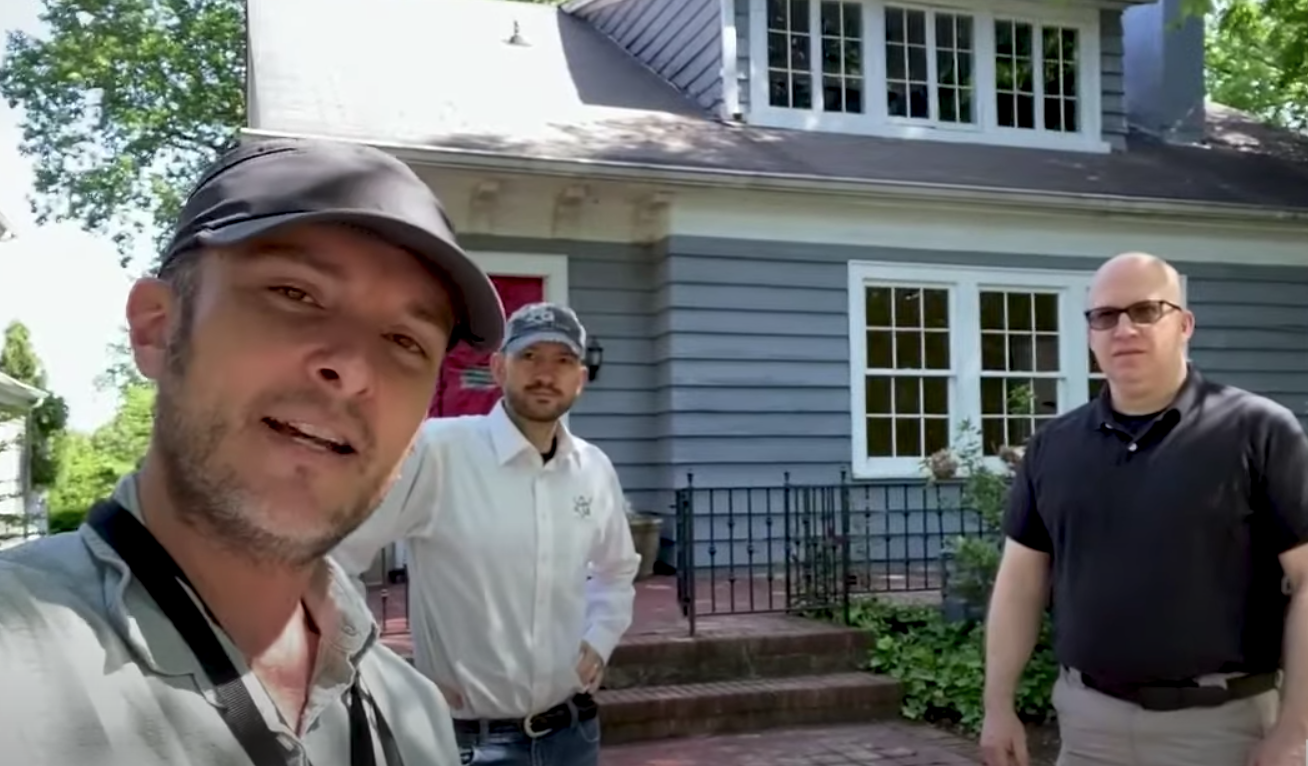Green Building Community
Discussing Air Tightness and Blower Door Testing with Corbett Lunsford, Matt Hoots, and Chris Laumer-Giddens (Video)
Posted by: Rate It Green Team
Follow along in this video as Corbett Lunsford of the Building Performance Workshop talks about air-tightness with Green Builder Matt Hoots of Sawhorse Inc. and Architect Chris Laumer-Giddens of LG Squared and performs a blower door test to measure air tightness at the #1920sMakeoverATL showhouse.
As part of the #1920sMakeoverATL whole house deep energy retrofit, Matt and the building team are running pre-diagnostics tests on the home, which will help them address performance issues relating to safety, comfort, and energy efficiency. The idea is to protect workers and make the right choices for the home. Potential additional tests include asbestos, lead, radon, duct blasting (not done on this project due to critters), and water quality. The team might normally test equipment for efficiency and safety, but this home’s equipment is too old and will be replaced. As Chris shares, The goal of testing is to find out "where we stand today so we can set our goals and see how much we can improve this and see where the opportunities are.”
Corbett walks us through the home and explains that the test will measure how much conditioned air one is losing to leakage, how much natural ventilation a house has. The test will also help ensure no back-drafting, where gases produced by fossil fuel combustion are not properly exhausted. The goal of a “tighter” and, therefore, less leaky house is to minimize leakage and therefore maximize HCAC systems operations and energy efficiency while also controlling ventilation and protecting air quality and health.
The test measures leakage by measuring the number of times the air volume in a house changes per hour (air changes per hour is also known as ACH) at 50 Pa, or Pascals, of air pressure. 50 Pascals of pressure is roughly about the same as a 20 mile per hour wind blowing on all sides of a house at the same time. During a blower door test, the building is depressurized about negative Pa of pressure, compared to the outside. The diagnostic professional will then record the volume of air leaking to keep the pressure at this level in cubic feet per minute of CFM. The number produced is then considered the ACH50 score of the building. The higher that score, the leader the building. High-performing homes typically have an ACH of 1.0 or better. Older homes that are leaky might have an ACH of 10 or more.
So, how leaky is the #1920sMakeoverATL home? Corbett, Chris, and Matt think it might be the leakiest home that’s been tested on record! As they suspected, the blower door test could not be properly run, as it would take 3 fans to get the home to 50 Pascals if this was possible. They produce and explain some numbers, but the test results aren’t really meaningful except to say there’s work to be done at this leakage level. The equipment records a score of 17, but the house can’t effectively even reach 50 Pa.
The team is ready to tackle the challenge. Matt explains that it would be a problem if his house were simpler tighter without proper ventilation, filtration, and humidity controls. The HVAC system gets a failing grade, there’s basically no building envelope and insulation, and the windows are rotting and moldy. If we simply tighter a building like this and don’t better manage air quality, we would likely have problems with air and mold. According to Matt, "You can smell the difference between a high-performance house and an older house.” With good ventilation and moisture management in a high-performing home, you don’t smell anything.
One of Matt’s key goals is "to demonstrate how this house that outperforms better than a newly constructed house built to current code in 2021-2022.” Simply stated, the plan is to get rid of bad air and avoid introducing new chemicals so future occupants can breathe clean air confidently and safely. Corbett also explains that airtightness directly relates to noise control and even smell, in addition to air quality and energy efficiency.
As Corbett shares, all the air we bring inside the house brings moisture and heat, and it all has to be controlled. The less air we bring in, the less energy it takes to control this air. The tighter the building, the fewer air leaks. A better-controlled indoor environment then means greater comfort and healthier indoor air quality, with more energy efficiency (and lower bills).
Follow along with the #1920sMakeoverATL project!
- Chex out our current project summary and status, and visit our Green Building Virtual Reality tours! Check out our #1920sMakeoverATL Discussion Area on Rate It Green, where we will announce all news and new content as it is published.
- Visit our YouTube Channel and our #1920sMakeoverATL Playlist! (Subscribe to our channel to be notified when new videos are released!)
- Join a special #1920sMakeoverATL newsletter list to receive more frequent project updates
What questions do you have about blower door testing and air quality or ventilation? What other aspects of a deep energy retrofit would you like to learn about? Want to get involved with the #1920sMakeoverATL project? Let us know!

Please be kind and respectful!
Please make sure to be respectful of the organizations and companies, and other Rate It Green members that make up our community. We welcome praise and advice and even criticism but all posted content and ratings should be constructive in nature. For guidance on what constitutes suitable content on the Rate It Green site, please refer to the User Agreement and Site Rules.
The opinions, comments, ratings and all content posted by member on the Rate It Green website are the comments and opinions of the individual members who posts them only and do not necessarily reflect the views or policies or policies of Rate It Green. Rate It Green Team Members will monitor posted content for unsuitable content, but we also ask for the participation of community members in helping to keep the site a comfortable and open public forum of ideas. Please email all questions and concerns to admin@rateitgreen.com

